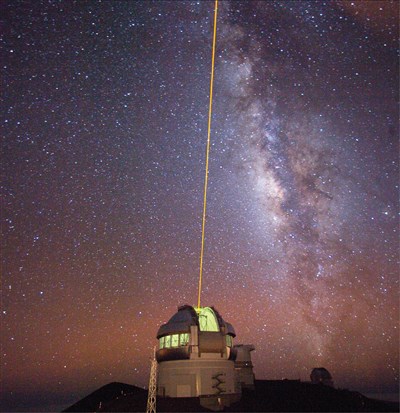Space race underway to create quantum satellite
March 4, 2013

Photons in space. Quantum communication between a ground station and a satellite in space could look something like this laser guide star system at the Gemini North Observatory in Hawaii. (Credit: Gemini Observatory)
In this month’s special edition of Physics World, focusing on quantum physics, Thomas Jennewein and Brendon Higgins from the Institute for Quantum Computing at the University of Waterloo, Canada, describe how a quantum space race is under way to create the world’s first global quantum-communication network.
The field of quantum communication — the science of transmitting quantum states from one place to another — has received significant attention in the last few years owing to the discovery of quantum cryptography, a way of creating “unbreakable” messages.
The transmission of encryption keys over long distances still remains a significant challenge for scientists, however, as the intensity of signals tends to weaken as they travel further because photons get absorbed or scattered off molecules.
Up until now, the furthest that quantum-communication signals have been sent is a few hundred kilometers, which would realistically enable communication between just one or two cities.
There is one place, however, where scattering doesn’t appear to happen — empty space. Jennewein and Higgins lead just one of several teams around the world looking to take advantage of this by pursuing the concept of a quantum satellite.
A signal traveling from a ground station on Earth to a satellite would spend most of its time in the empty vacuum of space — rather than in Earth’s atmosphere, which is crowded with gas molecules — so the signal would travel a lot further without weakening.
A satellite orbiting at around 32000 km above Earth would act as a kind of relay between two ground stations in a way that allows them to establish a secure link by sharing an encryption key made of photons.
In addition to the basic mass and power of the satellite itself, the team led by Jennewein and Higgins has been studying the overall design features of the satellite and ground stations and has emphasized the need for them both to be precisely aligned so they can be certain that what they are measuring correctly corresponds to the photons that are prepared.
“With the prospect of global-scale quantum communications and fundamental quantum science within new, unexplored regimes, the next few years are sure to be exciting,” they write.
